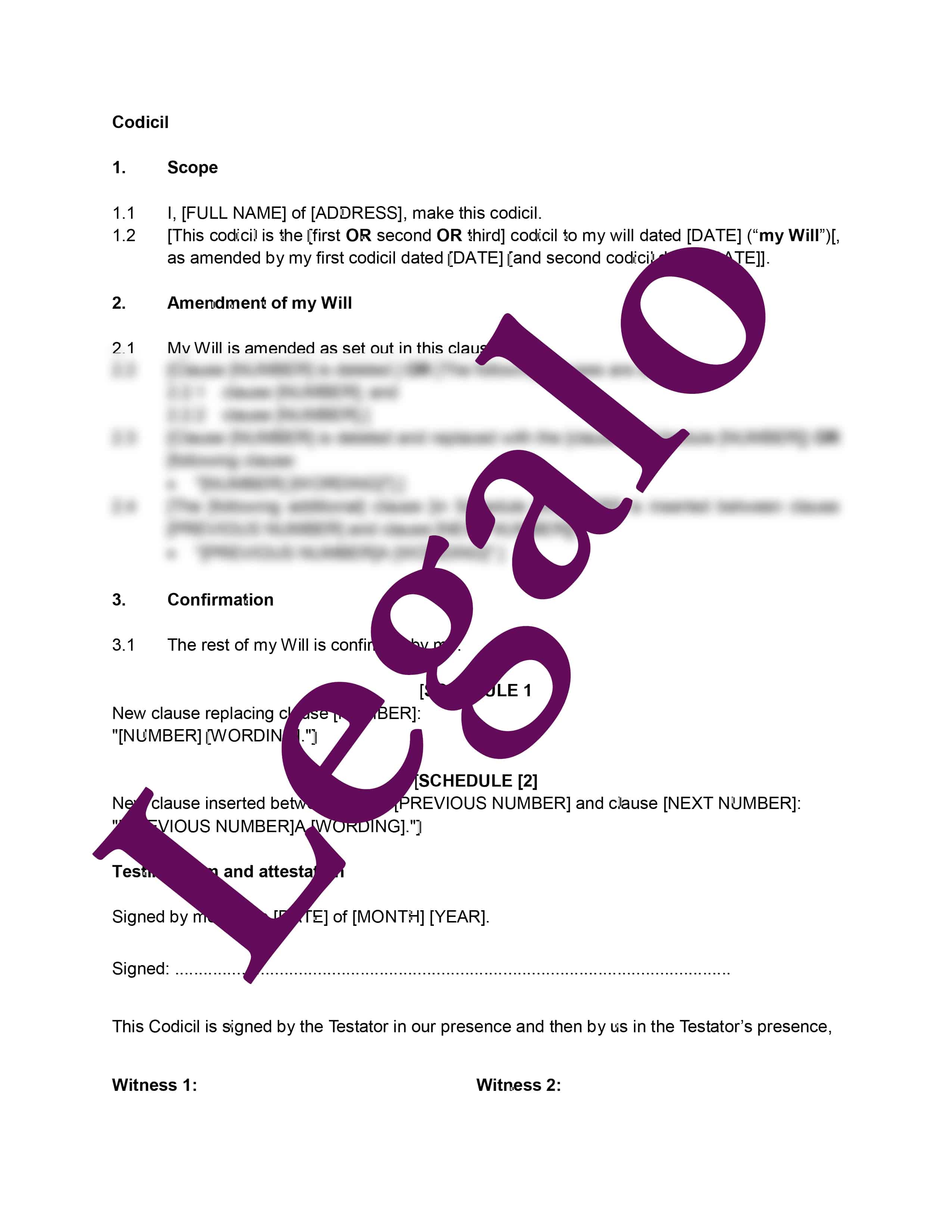Codicil to Will
Our general Codicil template:
- Amend your will without needing a lawyer.
- Over 700 codicil templates sold!
- Simple-to-edit codicil template form.
- UK-solicitor-drafted template for reliability.
- Legally-binding and valid document.

How Does It Work?
-
1. Download
-
2. Edit
-
3. Print
-
4. Sign
MD, Legalo Ltd; Solicitor; Notary Public
Our codicil template is a simple document – use it to vary your existing Will easily and quickly.
This is one of our best-selling templates, with over 700 sold!
This Codicil to a Will is in template form. You can easily edit it, with the aid of our full guidance notes, which are included. It is suitable for wills made anywhere in the UK – Scotland, Northern Ireland, England and Wales.
Prepared by David, our co-founding lawyer, you get a document that can be relied on to be legally binding and valid, whilst being cost-effective.
David has written this short-form document in plain English, so it is free from legal jargon.
Using this Template
Download the document in Word format and then edit it on your computer. We have highlighted, with square brackets, the blank areas that you need to edit to adapt the template to your specific requirements.
We have carefully written detailed guidance notes that are included with the downloaded template.
These notes explain each clause and how to complete the Codicil to amend your Will.
Finalising it is quick and simple.
Using our guidance notes, you should be able to complete your template within 10 minutes. It is a printable document. Just print it off and then carefully sign it. Follow the signing instructions that are in the guide which accompanies it.
This is the standard version of this template. We have pre-edited versions for making common amendments to a Will. You can browse them in our Wills and Probate section.
What is a Will Codicil?
You can use a Will Codicil to amend the terms of an existing Will legally. (See Wikipedia’s explanation of what a codicil is here.)
View a sample of our template by clicking the sample ‘preview’ button above.
Once completed, you keep it with your Will. It acts as an addendum to the Last Will and Testament.
The amendments will be just as legally binding as your Will, so set out the changes in the Codicil once you have decided on them.
You fill in the date that you signed it. Then there can be no confusion about what your current wishes are. You can amend any of the terms of your existing Will, including details of your executors.
Signing
Once you have drafted and printed your Codicil, then you will need to sign it in the presence of two witnesses, who must also add their signatures. This is just as you did with your Will, to make it legally valid and enforceable. It is very important that you take care over this to get it right. Just like with your main Will, the 2 witnesses must be adult witnesses, preferably unrelated to you. A beneficiary under your will or codicil should not be used as a witness. If you do, you might invalidate the legacy you are leaving them.
Once you have done this, then it will effectively become part of your Will.
Adding a Codicil is a most cost-effective way of amending your Will. You do not have to pay a solicitor to draw up one when you use our online template.
Before going ahead with your template, you must bear in mind that a Codicil is better for making only small changes only and, if you want to draft many, it would be better to draw up a new Will. You can see our full range of Will templates here.
Other Codicil templates available
If you only want to make one alteration to your will, then we have some more specific codicils available, which are even simpler to use. Our specialised Codicil templates are:
- Specific codicil to add a new beneficiary;
- Specific codicil to alter a gift to a charity; and
- Specific codicil to change an executor.
FAQs on Codicils
Below we have answered popular FAQs from the Internet.
Is a Codicil to a Will legally binding?
Yes, if correctly signed / executed, a codicil will be just as valid as the will that it alters or supplements. Our guide to the template tells you exactly how to sign the codicil to ensure it is valid and binding – in simple terms you sign it with 2 witnesses, in a similar fashion to how you signed your will in the first place.
Can I change the executor of my Will without a solicitor?
Yes, as with all of Legalo’s templates, you do not need to employ the services of a solicitor to carry out this reasonably straight-forward legal work yourself. With a Legalo template Codicil, you will receive a written guide, which tells you exactly what to do to make your own Codicil. If the only thing you are changing is an executor or two, then you may prefer our customised template Codicil to change an executor – just click on the link.
Is a Codicil different outside of the UK?
If your Will is an English Will, then you will want an English Codicil to amend, vary or supplement it. If you use another country’s codicil template, then you may find it is not valid for use with an English will. For one thing, often other countries have different signing requirements, which might not match ours, and therefore might invalidate your codicil.
If you are not resident in the UK (and do not have assets here), then you should use a Will or Codicil template that is specific to the country you live in. You can then be sure you are making a valid Will or Codicil.
Why does it need to be a UK-based template?
As above, you would need a Codicil based on English law in order to amend, vary or supplement a Will made in accordance with English law. If this is what you need, then look no further than this template from Legalo.
Can I add a codicil to my Will without a lawyer?
You can, and, with Legalo’s codicil template, it is so quick and easy to do. Thousands of people are discovering just how much legal work they can do themselves with the benefit of Legalo’s straightforward templates and guides.
How easy is it to add a codicil to a Will?
With Legalo’s template for a codicil this is very simple. Our template is a short document that you can complete in minutes. It comes with a full written guide too.
What is an example of a codicil?
You can see an example, or preview, of our template by clicking on the purple “Preview Document” button to the right of this page, just below the price.
Can you hand write a codicil?
Yes, this is not a problem. The main things are (a) to be clear on what you are saying and (b) in signing it properly. See below on the latter. Our template will make your task much easier though. It is in the right format and comes with a full guide to tell you what to do. It includes detailed signing instructions, as it is important that you sign the codicil correctly.
Is there a form for a codicil?
No, but templates are available, which make the job of writing a codicil very easy, such as Legalo’s great template. Our template is one of the most popular codicil templates on the Internet.
How should a codicil be worded?
The codicil should refer to the existing Will that it amends or supplements and should make it clear what it is changing, deleting or adding. It then needs to be signed correctly.
How do I add a codicil to an existing Will?
When you have an existing Will, you can add a codicil to it, to modify the Will, by using a template, such as Legalo’s one, or you can pay a solicitor to draft the new codicil for you.
How much does a codicil cost in the UK?
Legalo’s template is just £19.95. We estimate a codicil from a firm of solicitors will cost you around £150 plus VAT.
What is a valid codicil? What is required for a codicil? How do you write a codicil to Will in the UK?
A valid codicil is made by writing what you want to change in your Will or what you want to delete from it or add to it, then signing it validly (see below) and then putting the date on it.
What makes a codicil invalid?
Signing it improperly, or not at all, can render a codicil invalid. If an existing beneficiary acts as the witness, then this may invalidate any gift to them made by the codicil. Attempting to make a codicil when you do not have the mental capacity to do so (or to understand what you are doing) also invalidates the codicil. Failing to date it can make it invalid.
Someone trying to make a codicil on behalf of someone who has lost mental capacity is also invalid. You cannot do this even under a Lasting Power of Attorney (LPA). It is simply too late to change someone’s will or make a codicil for them, once they have lost mental capacity but while they remain alive.
Who signs a codicil to a Will? How do you execute a codicil?
It has to be signed in the same manner as a Will in order to be valid This is very important. So 2 adult witnesses are required who are not related to the person making the codicil and are not beneficiaries under the Will or codicil. The witnesses must be present when the person signs the codicil and see the person sign it.
Is codicil a separate document?
It is its own document. It supplements (and amends) an existing Will. Once signed and dated, you keep it in a safe place with your latest Will.
Is a codicil a public document?
It is a private document until after the person making it has passed away, then it is sent off to the Probate Registry, along with the Will if you need to apply for a grant of probate. Both become public documents at that point.
Is registration of codicil compulsory?
If you need to apply for a grant of probate, then registration of it at that point (by filing it with your application for the grant) is compulsory. You don’t register it when you make it, or at any time while you are still alive. When you apply for the grant of probate you would send off the original of the Will and the originals of any Codicils. They then go on the public record.
What can a codicil cover?
It can cover any topic that could be covered by a Will. So you can amend any existing clause in the Will or add any new provisions to it that the Will does not yet cover. Most people use a Codicil to change an executor or update a legacy.
What is the difference between a codicil and an amendment to a Will?
A codicil does amend a Will. You can also amend a Will by scrapping the existing one entirely and replacing it with a full new one. If you only want to make a couple of changes then a Codicil is appropriate. However, if you want to make significant changes to your Will, then starting over with a fresh Will would be the better option. A lot of people just want to make one change, such as replacing an executor or updating a legacy. For that a Codicil is the simplest option.
Guide to our Template
Below we have printed an excerpt from the guide to this template (the full guide comes with the template when you buy it):
1. Scope
In clause 1.1 please insert your full name and home address. In clause 1.2, if you have not made previous Codicils to your current Will, then adjust the wording so it is clear this is your first such amendment to your current Will. If this is your second or third Codicil to your current Will, refer to the previous ones. Fill in the dates.
2. Amendment of my Will
This is the main clause in the Codicil that amends the Will. Here you can specify the to your Will.
If you are deleting provisions from your Will and not replacing them, then use clause 2.2. Here you have 2 options. If only deleting one clause, use the wording of option 1; when deleting more than 1 clause, then use option 2 and, in either case, set out the relevant clause number(s).
If you are deleting a clause in the Will and replacing it with new wording or amending the wording, then use clause 2.3. Refer to the clause you are deleting. It is best to set out the wording for the whole new clause here in the Codicil. Rather than trying to refer to certain words phrases or sentences of the original clause in the Will as being deleted and replaced with new ones or in a schedule (if the wording is lengthy or complex).
If using a schedule in the codicil, refer to the number of the schedule here, and then fill in the schedule. In the schedule to this guide, which is below, you will find a sample of helpful clauses that you might like to use to help you word your new clause. You can copy and paste them into the Codicil template.
If you are adding a new clause, use clause 2.4 for this. As before, it is best to set out the wording for the whole clause here or in a schedule. If using a schedule, refer to the number of the schedule here, and then fill in the schedule. As noted above, the schedule to this guide has a sample of helpful clauses that you might like to use.
Delete any of clauses 2.2 to 2.4 that you don’t need to use.
3. Codicil Confirmation
This clause confirms that, other than the changes made by the Codicil (or previous Codicils), the rest of the Will remains in force.
Schedule 1
As noted above regarding clause 2.3, if you are replacing a clause in the Will with a lengthy new clause, then you can set it out here. Fill in the number of the clause from the Will that you are replacing in the 2 places and then fill in the new clause’s wording in its entirety.
Schedule 2
As noted above, if you are inserting a lengthy additional clause into your Will, then you can set it out here. If there is no other schedule, then renumber this as schedule 1. Fill in the numbers of the 2 clauses from the Will that this additional clause slots in-between; then fill in the number of the new clause and its wording.
Signing
The guide then sets out the precise signing instructions you need to follow.
Once signed, you store your Codicil with the original of your Will. A simple and cheap storage solution is to use the £20 Probate Registry will and codicil storage service (click here for details).
As you can see from the guidance notes above putting in place a codicil is easy. The simple way to amend your Will.





